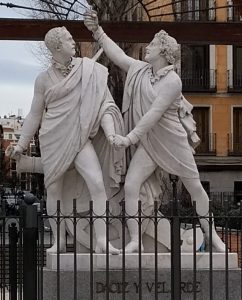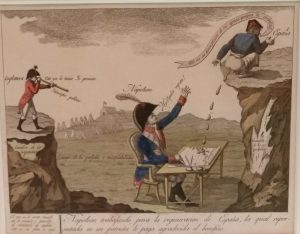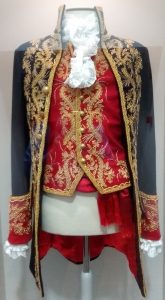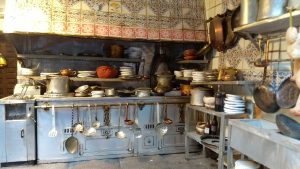In late March, Teresa and I took the train to Madrid to meet my sister-in-law Jeannie, who was traveling in Europe this summer. Jeannie had found an AirBnB flat for us to share in the Lavapies Plaza neighborhood – wonderfully located for visitors on foot. Some say it can be a slightly sketchy neighborhood – and it’s true that the prior weekend had seen riots in this neighborhood populated largely by new immigrants – but all was calm while we were there.
I had no particular agenda for Madrid other than a desire to see the immense Guernica canvas by Picasso in the Reina Sofia art museum. As with most places we visit, I mostly just wander around and allow myself the luxury of being side-tracked by whatever looks promising.
The morning after we arrived, Jeannie suggested that we find the Museo Chamberi, a ghost metro station left over from the 1960s do-over of the Madrid metro system, but it was closed for repairs when we finally found it. Our map indicated that Plaza Dos de Mayo was nearby so we checked that out instead.

Dos de Mayo (May 2nd) is a holiday in Madrid, as well as the name of innumerable streets and plazas throughout Spain, so I wanted to learn more about it. During the Napoleonic Wars of the early 1800s, Madrid was occupied by French troops. During a popular uprising by the populace against the occupiers, two Spanish officers (Daoiz and Velarde) joined the rebellion and have ever since been celebrated as the heroes of the rebellion. This is important because it triggered the Peninsular War which is regarded as one of the first wars of national liberation, and is also significant for the emergence of large-scale guerrilla warfare tactics.
The plaza was a bit of a disappointment. There was the statue of the heroes of the day, but their swords were broken off. Totally ruined the effect, as it now looks as if they are holding hands while gazing intently at each other.
One of the Spanish national museums of art is the Reina Sofia, and it offers free admission from 7-9 pm. It has a very large collection of 20th century Spanish art, including a lot of Picasso and Dali. We went on a Friday evening – the line for free admission was relatively short and we checked out the Guernica painting by Picasso. Their display also included some x-ray evaluations of the canvas and you could see how he had painted over extensive parts of it, changing it quite significantly while it took on its final form.
Saturday was cold, cloudy and windy all day. Jeannie wanted to see the San Miguel Market so we started walking in that direction. Along the way we passed by some delightful murals, including one dedicated to Women’s Day. A partial shot of that mural is the featured image for this posting. The market turned out to be dedicated to gastronomic delights and other assorted gourmet tapas — just an outstanding place to be for today’s almuerzo (read more on the 5 daily meals of Spain).

After our mid-morning snack, it was on to the History Museum of Madrid. I found it quite interesting. Madrid was a backwater town until Phillip II decided to move the court there in 1560. Also learned a lot more about the peninsular war and some of the subversive political cartooning that went with it.
After lunch and a siesta, we thought we’d try getting into the Prado art museum, as it is also free admission after 6pm. But the lines were way too long. Jeannie and Teresa decided to return another day (and pay full fare). The Spanish Naval museum was close by, so we went there instead and discovered some interesting old maps of America, as well as a lot of uniforms, tools and ship models relating to the heyday of the Spanish Armada several hundred years ago. My dad, with his background in naval engineering, would love this place. 
The Naval Museum kicked us out at closing time, so what to do next … How about the Pensioners Protest Parade? It was in full swing just across the street from the museum when we left! I guess those retired people just have too much time on their hands…
The next day, Teresa & Jeannie visited the Prado (Teresa’s favorite art museum in Madrid), but I wanted to see the Archaeology Museum so we split up for the afternoon. My GPS map led me to an enormous building – a museum – but when I got in I realized it was the museum of the national library — so I decided to see it instead.

There were numerous ancient mathematics and astronomy texts on display – from 12th century Andalusian Moorish astronomers through more modern texts by Tycho Brahe. I also saw a 1276 astronomy text attributed to Alfonso X also known as (the Wise) who promoted the use of Castilian (rather than Arabic or Latin) as the primary language of higher learning, science and law in the Iberian peninsula. Arguably, this promotion led to our present day situation in which Spanish is the world’s second most spoken native language (after Mandarin Chinese).
I had never given any thought to Alfonso X until visiting this library, but he was really a remarkable character in Spanish history. In addition to his promotion of the Spanish language Alfonso also was responsible for developing:
- the Alphonsine Tables (to compute position of Sun, Moon and planets)
- the Siete Partidas (first vernacular law code in Spain), later used quite extensively to develop the laws of the Americas. They included interesting concepts such as “ignorance of the law is no excuse”, and how to determine whether a ruler is a tyrant. The United States Capitol has a relief bust of Alfonso gracing the chamber, in recognition of his work in establishing the principles that underlie American law.
- the Mesta (first agricultural union in medieval Europe). Among other things, the crown granted rights-of-way (which prohibit building or blocking these paths “forever”) to the Mesta for them to herd sheep. Some of the streets in Madrid remain as part of this system, and herders still will occasionally drive sheep across the city along these protected pathways.

On Monday, we finally got another nice sunny day, and we decided to check out the parks. Oops! The big, huge public garden in the center of Madrid was closed due to damage from a windstorm over the weekend. This gave us plenty of time for lunch — so for our last full day here we decided to dine at the world’s oldest continuously operating restaurant – Restaurante Sobrino de Botín.
Opened in 1725, the flame in the oven has supposedly never been extinguished. In Hemingway’s “The Sun Also Rises”, he mentions their house specialty – “roast suckling pig”. It was delicious!
After getting up on Tuesday we all grabbed our suitcases and walked 15 minutes to the central train station for the 3 hour ride to Barcelona. The next day, we took the local train to the airport to meet Jamie, who was flying in at 10am. Jamie didn’t have a working phone, and our signals got crossed about where in the airport to meet … eventually, I received a phone call from some random individual with a Texas phone number – and Jamie’s voice told me that he was waiting in front of our apartment building.
From this point, my path diverged from Teresa’s for about a week, as some of us were interested in architectural landmarks, others had different things in mind.
Some of the sites visited were:
- Casa Vicens (by Gaudi)
- Casa de los Punxtes (one of Teresa’s favorites)
- Sagrada Familia (by Gaudi, if you go, try for a time when the crowds aren’t too bad)
- Hospital Sant Pau
- Parc Guell (by Gaudi)
- Montjuic Cemetery (lots of spectacular monuments, and also, don’t miss the horse-drawn hearse collection)
We also managed to visit flea markets, a calçotada, JazzSi Tuesday jam session, and a Sardana dance band playing a bunch of traditional Catalonian wind instruments (and a 3-string double bass). Check out the video.
[youtube https://www.youtube.com/watch?v=j-17tgc45Mw&w=640]
Note the band leader in the front row at the left. He’s also keeping rhythm with an elbow drum while playing a keyed flaviol (which seems like it might almost work as a universal tin-whistle).
Trip to Nîmes
Jeannie had a friend, Karin in southern France near Nîmes that she wanted to visit, so Jamie and I (Teresa) tagged along. Roy felt a cold coming on so he stayed home to recuperate. Our drive to Nîmes avoided toll roads and took us 7 hours. Our host Hans called it the route of 1,000 roundabouts and I think that was pretty accurate. The drive back on the toll roads took 4 hours. 
While there we visited a little fortified village on the coast, Aigues-Mortes. Louis IX, who later became Saint Louis, was instrumental in the building of this fortified village.
We also visited Nîmes – also known as the Rome of southern France. It has the finest collection of Roman buildings in France and is a beautiful town. It was not at all crowded with tourists when we were there.
The next morning we ladies visited the market in nearby Sommières. It was a combination flea and farmers market.
Jeannie and I could have spent the entire day there. It had something for everyone!
Our evenings were spent lingering over long dinners with endless glasses of French wine. We had a wonderful time visiting Jeannie’s friends Karin and Hans.
January, 1968, on way to India (via Spain, Libya, Lebanon, and Iran), a group of us on the expedition went to the Restaurante Sobrino de Botín. I had the suckling pig, but it was too much for some of the party to contemplate. I think I spent an extravagant $5 for the meal. Of course, we were actually staying in hotels for the equivalent of ~$1.50/night/person. Fun times with multi-story buildings having family hotels on different floors. Got overwhelmed by the Prado after 2-3 hours, as I usually do in such places.
Glad to see you are having a really great time.
Dennis
Prices have gone up considerably in the past 50 years … The Suckling Pig Special, including sides and a bottle of wine now costs closer to 40 euros or so … Probably the most expensive meal I’ve had in Spain.
How was the Iranian cuisine? It doesn’t look like I’ll have a chance to go there, politics being what it is these days…
We didn’t have much time in Iran. Pretty much an overnight, as I recall.
What I remember most is being introduced to having rice (very hot) served with a side of a raw egg. Crack the egg, separate white and yolk, drop yolk in the hot rice, and stir with fork. Eat. Delicious.
I think we may have had lamb, but the egg is what stands out as food.
Early 1968 was certainly a different time in Teheran. Persian with a strong western overlay in the city. Times have certainly changed.
Cool band. i wonder how the 3 stringed bass is tuned. love readiing about your travels.
D
Great question … I was wondering about the tuning as well. I’ll have to go back some Sunday when the Sardana band is playing again and ask about it.
The two of you are quite awesome and incredibly inspiring. Thank you!!